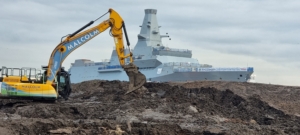CASE STUDY
Date: January 2023
Client: Graham
Project: Clyde Waterfront and Renfrew Riverside project
Deep Soil Mixing Ltd has successfully completed a mass mixing project for client GRAHAM, installing a new culvert alongside a new swing bridge as part of the design and construction work for the Clyde Waterfront and Renfrew Riverside project.
GRAHAM won the contract from Renfrewshire Council to undertake and deliver on the project.
The construction work included the conversion of an old culvert into an open waterway and building a two-lane opening road bridge across the River Clyde at Renfrew as well as a 750-metre development road that connects into the Advanced Manufacturing Innovation District Scotland (AMIDS) by Glasgow Airport – and Deep Soil Mixing Ltd was responsible for the design, supply and installation of all the soil mixing ground improvement solutions needed for the construction work.
The Solution
The existing site soil that the new culvert and bridge were to be built on, was not strong enough and needed to be stabilised and strengthened.
The 100-year-old culvert that carried the River Clyde tributary needed to be relocated to avoid the proposed location of the new Clyde Bridge. As the ground was mostly manmade and 4.0 – 5.0m deep, this material was not suitable for forming an open channel. To combat this, designers Ramboll specified soil mixing to stabilise the ground and enable the excavation of a channel and embankments as well as lock in the contaminants from the manmade ground. As a result, a new open waterway could be installed, improving the surrounding area with this new open river channel, and all without the concern of contaminants leaching into the water.
GRAHAM considered using piling as a solution to strengthen and improve the soil. However, Deep Soil Mixing Ltd consulted with GRAHAM to form a good working relationship on how best to achieve the required effects and minimise the amount of excavation needed – and demonstrated that soil mixing would be superior for the project as it not only greatly enhances the characteristics of the existing soil, but it is the most cost-effective and environmentally friendly option, as no lorry loads of soil are removed from the site and there is no spoil at the end.
Mass soil mixing was used to improve the geotechnical qualities of the site soil and to provide a stabilised mattress area for an open and closed culvert, situated on the north side of the new Clyde Bridge.
The soil was mixed up to a depth of approximately 4 metres using a 35-tonne excavator with an MB900 mixing arm, to achieve the required high level of soil quality for the construction work.
The soil mixing started in early November 2022 and the project took approximately 12 weeks to complete.
The Project
During the first phase of the project, soil samples were trialled to confirm the required binder to match the geotechnical values needed for the work.
Once established, the binder was mixed with the existing site soil to the needed depths of up to 4 metres, using Deep Soil Mixing Ltd’s MB900 mixing arm attached to a 35-tonne excavator. The machine efficiently improved the site soil’s geotechnical qualities by mixing it with the right binder in-situ.
As a result of using mass mixing to improve the ground, construction of the twin-leaf swing bridge over the River Clyde and the Renfrew North Development Road was able to progress quickly and efficiently.
The project also included building improved routes for walking and cycling that link to Yoker train station and the national cycling network.
The project was funded by the Glasgow City Region Deal to create an appealing waterfront area and provide practical benefits for the surrounding areas. Communities are better connected to work, health, education and leisure thanks to the new bridge.
GRAHAM’s said: “We’re delighted with how Deep Soil Mixing Ltd has handled this project – from start to finish, they’ve been brilliant to work with. They fully understood the needs of the construction work, and advised on the most suitable, cost-effective and sustainable option to get the ground ready for both the new waterway and the bridge by improving the site soil.
“It was a bonus that the soil mixing was undertaken with minimal inconvenience for the local residents thanks to the method being vibration-free and carried out in a way that keeps the site free of spoil and lorries.
“The resulting culvert and swing bridge are fantastic and will be a great asset for the surrounding communities for years to come.”
What are the benefits of using soil mixing?
Environmentally Friendly & Economical: Natural resources are spared as existing soil is used as aggregates. Many forms of contaminated ground can also be mixed which reduces transportation of raw materials to landfill. The use of soil mixing can also reduce construction programme and reduces carbon footprint with less vehicular movements.
Flexible: Effective on different soils, including soft soils, flood plains, contaminated land, peat, silts and alluvium etc. Flexibility also in design and application as well as installation of the soil mix not being affected by the weather. The final cured product can also be shaped, benched or battered to suit.
Reduces Construction Programme
Reduced Vibration: Soil Mixing induces very low vibrations, which reduces the potential impact to nearby utilities.
Increases bearing pressure, controls settlement and reduces permeability.
Wide range of soils can be treated compared to other solutions
No need to bring costly and bulky materials on site
Reduces vehicle movement and therefore improves site safety






